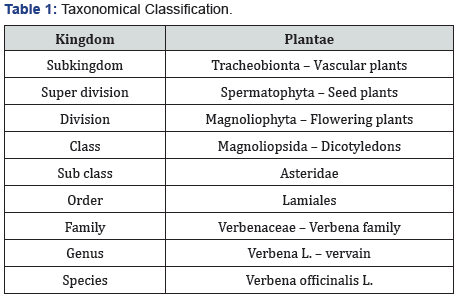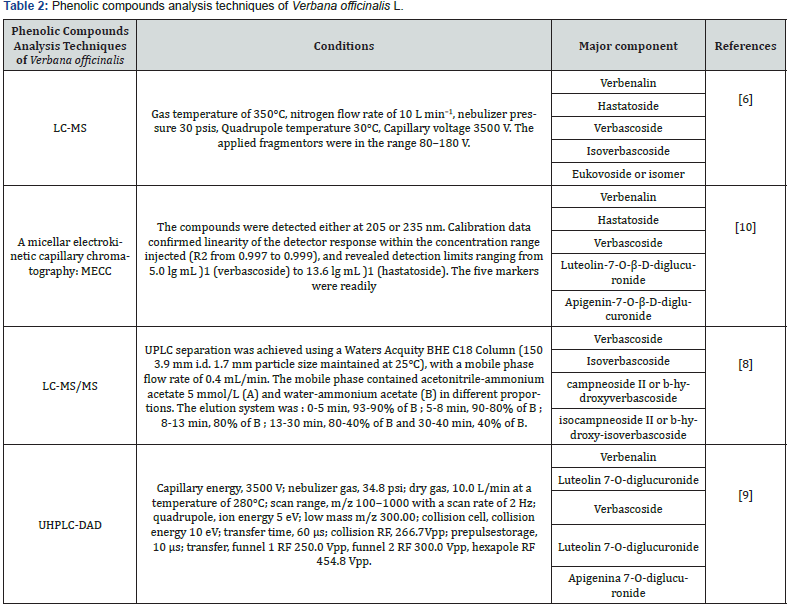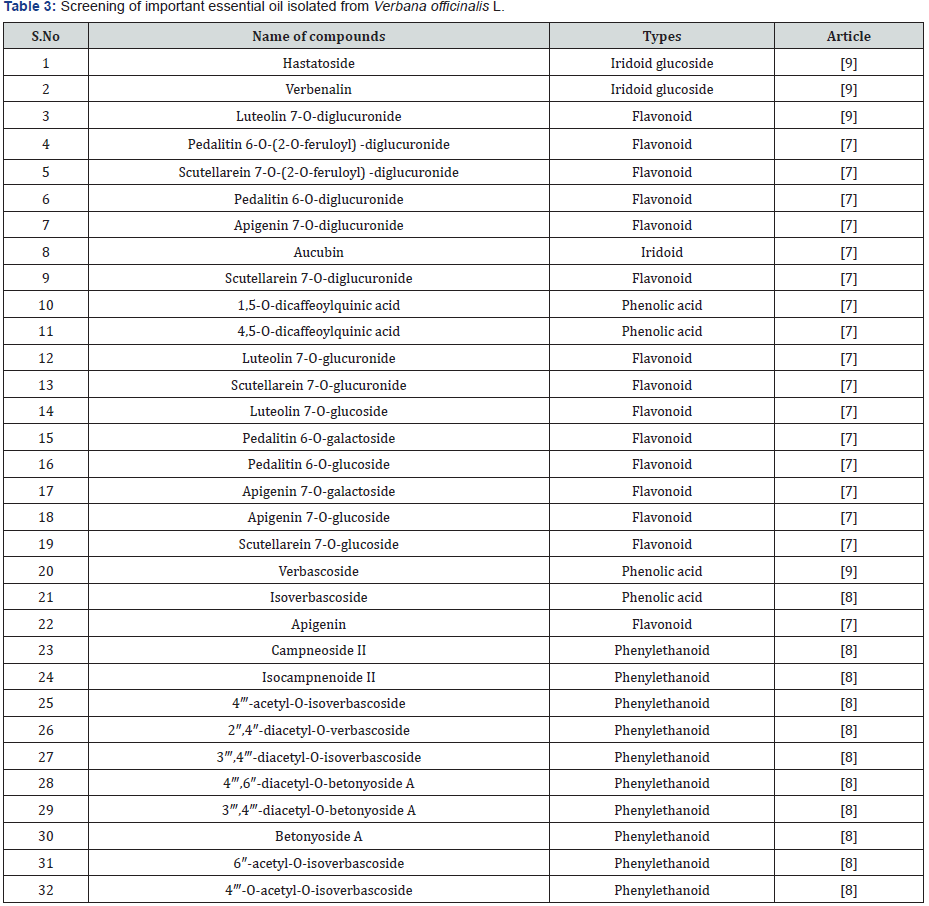Phenolic Substances and Biological Activities of Verbana officinalis L.: A Mini-Review
Hajer Riguene1, Ghayth Rigane1,2* and Ridha Ben Salem1
1Organic Chemistry Laboratory LR17ES08, Sciences of Sfax Faculty, Chemistry Department, University of Sfax, Tunisia
2Faculty of Sciences and Technology of Sidi Bouzid, Department of Physics & Chemistry, University of Kairouan, Sidi Bouzid, Tunisia
Submission: January 15, 2019; Published: February 05, 2020
*Corresponding author: Ghayth Rigane, Organic Chemistry Laboratory LR17ES08, Sciences Faculty of Sfax, University of Sfax, Tunisia.
How to cite this article: Hajer R, Gayth R, Ridha B S. Phenolic Substances and Biological Activities of Verbana Officinalis L.: A Mini-Review. Organic & Medicinal Chem IJ. 2020; 9(2): 555758. DOI: 10.19080/OMCIJ.2019.09.555758
Abstract
The published data related to the identification of the major phenolic compounds as well as its biological activities present in Verbana officinalis L. This plant has received a great interest in the worldwide for its diuretic, expectorant and anti-rheumatic, anti-inflammatory, antifungal, antibacterial, analgesic and antioxidant activities.
Keywords: Verbana officinalis L; Phenolic substances; Biological activities
Introduction
Verbena officinalis or commonly referred as vervain belongs to the verbenaceae family (Table 1) which can be found in West Asia, North Africa and throughout Europe [1]. It is listed in the Chinese Pharmacopoeia and the British Herbal Pharmacopoeia [2]. Verbana is a medicinally used herb, where most people still depend on the folk medicine, despite the great progress in all opathic medicines, particularly to all eviateanxiety, insomnia, depression [3]. Verbena officinalis has been widely used for amenorrhea, insufficient lactation (lactogogue plant), assisting contractions duringlabor, promoting wound healing and for disorders of menstruation [4].

Botanical Characteristics

Verbena officinalis is a perennial herb. It is erect, 25–100 cm tall and branched above. Its leaves are 3.5–8 cm long and 1.5–3.5 cm broad. It has pale pink or purplish color flowers about 4 mm across [5] (Figures 1 & 2).

The Chemical Composition of Verbana officinalis

The main class of compounds of these plants were phenylpropanoids, being verbascoside the most abundant in all the preparations up to 97 % of the total phenylpropanoids. In addition, iridoids, has hastato side and verbenalin together with flavonoids, mono- and di-glucuronidic derivatives of luteolin and apigenin were found [6] (Table 2).
Several analytical techniques were used in order to identify and quantify the phenolic composition of Verbena officinalis, these techniques included high-performance liquid chromatography- mass spectrometry (LC-MS) [6,7], high-performance liquid chromatography-mass spectrometry/mass spectrometry LC-MS/ MS [8], ultra-high performance liquid chromatography diode array detector UHPLC-DAD [9], Micellar electro kinetic chromatography MECC [10] and High-performance liquid chromatography with diode-array detection HPLC-DAD [7] (Table 3).

The Biological Activities of Verbana officinalis
The famous properties of vervain herb are sedative, antispasmodic and diaphoretic [11]. Verbena officinalis L. has been traditionally used as nervine tonic, antidepressant, and anticonvulsant; prescribed in liver and gall bladder complaints (spasm of the bladder and strangury), nervous and menstrual disorders; also, for bronchitis, asthma and febrile affections [12].
In addition to that, Verbana officinalis can be utilized to treat enteritis, acute dysentery, depression and amenorrhea [13]. The scavenging activity against DPPH (1,1diphenil-2-picrylhydrazyl) radical and the antifungal effect against chloroform, ethylacetate and 50% methanolic extracts of Verbena officinalis leaves were investigated. The activity of different fractions of 50% methanolic extract and some isolated compounds were also investigated. The results suggest that 50% methanolic extract and caffeoyl derivatives could potentially be considered as excellent and readily available sources of natural antifungal and antioxidant compounds [2].
The antimicrobial potential of verbana herb leaves, and roots was evaluated against 24 strains of Gram-positive and Gram-negative bacteria by Dildar [5]. Ethanolic extracts of stems, leaves, and roots of Verbena officinalis and their fractions in various solvents were assessed. The stems proved to be most potent against all the strains. Its activity against Staphylococcus aureus and Pseudomonas aeruginos a was higher than the antibiotic Amoxicillin.
The leaves also showed considerable activity against Pseudomonas aeruginosa, Citrobacter freundii, and Staphylococcus aureus. The roots turned out to be highly effective against Bacillus subtilis, Staphylococcus aureus, and Pseudomonas aeruginosa. The study confirmed the efficacy of Verbena officinalis against infectious diseases. While all the three parts of the plant were active against the test micro-organisms, stems were most powerful. The plant has great potential to provide exploitable leads for new antimicrobial drugs [5].
Conclusion
The biological activities of Verbana officinalis L., including antioxidant, anti-microbial, anti-inflammatory and anti-cancer, were due to the presence of bio-active compounds in the leaves such as: Verbenalin, Hastatoside, Verbascoside, Luteolin-7-O-β-D-diglucuronide, Apigenin-7-O-β-D-diglucuronide.
References
- Abebe M, Abebe A, Mekonnen A (2017) Assessment of antioxidant and antibacterial activities of crude extracts of verbena officinalis Linn root or Atuch (Amharic). Chem Int 3: 172-184.s
- Casanova E, García Mina JM, Calvo MI (2008) Antioxidant and Antifungal Activity of Verbena officinalis L. Leaves. Plant Foods Hum Nutr 63: 93–97.
- Abdulmannan HF, Zahurin M, Zamri C, Abdulsamad A, Siti RMZ, et al. (2019) Prenatal developmental toxicity evaluation of Verbena officinalis during gestation period in female Sprague-Dawley rats. Chem Biol Interact 304:28-42.
- Abdulmannan HF, Zahurin M, Zamri C, Abdulsamad A, Siti RMZ, et al. (2019) Mutagenicity and genotoxicity effects of Verbena of icinalis leaves extract in Sprague-Dawley Rats. J Ethnopharmacol 235: 88-99.
- Dildar A, Kamal AQ, Chaudhary MA, Husnul M (2017) Verbena officinalis a herb with promising broad spectrum antimicrobial potential. J Med Chem 3(1).
- Bilia AR, Giomi M, Innocenti M, Gallori S, Vincieri FF (2008) HPLC–DAD–ESI–MS analysis of the constituents of aqueous preparations of verbena and lemon verbena and evaluation of the antioxidant activity. J Pharm Biomed Anal 46: 463-470.
- Rehecho S, Hidalgo O, Cirano MGI, Navarro I, et al. (2011) Chemical composition, mineral content and antioxidant activity of Verbena officinalis L. LWT - Food Sci Technol 44: 875-882.
- Encalada MA, Rehecho S, Ansorena D, Astiasaran I, Cavero RY, et al. (2015) Antiproliferative effect of phenylethanoid glycosides from Verbena officinalis L. on Colon Cancer Cell Lines. LWT - Food Sci Technol 63: 1016-1022.
- Eisath NG, Eichberger M, Gruber R, Sturm S, Stuppner H (2018) Development and validation of a rapid ultra-high-performance liquid chromatography diode array detector method for Verbena officinalis L. J Pharm Biomed Anal.
- Müller A, Ganzera M, Stuppner H (2004) Analysis of the aerial parts of verbana officinalis L. by micellar electrokinetic capillary chromatography. Chromatographia 60: 193-197.
- Kubica P, Szopa A, Ekiert H (2017) Production of verbascoside and phenolic acids in biomass of Verbena officinalis L. (vervain) cultured under different in vitro conditions. Nat Prod Res 31(14):1663-1668.
- Kumar P, Madaan R, Sidhu S (2017) Antianxiety Activity of Fractions and Isolated Compounds of Verbena officinalis Aerial Parts. Int j pharm sci drug res 9: 79-82.
- Sumaira, Afridi MS, Hashmi SS, Ali GS, Zia M, et al. (2018) Comparative antileishmanial efficacy of the biosynthesised ZnO NPs from genus Verbena. IET Nanobiotechnol 12(8): 1067-1073.






























